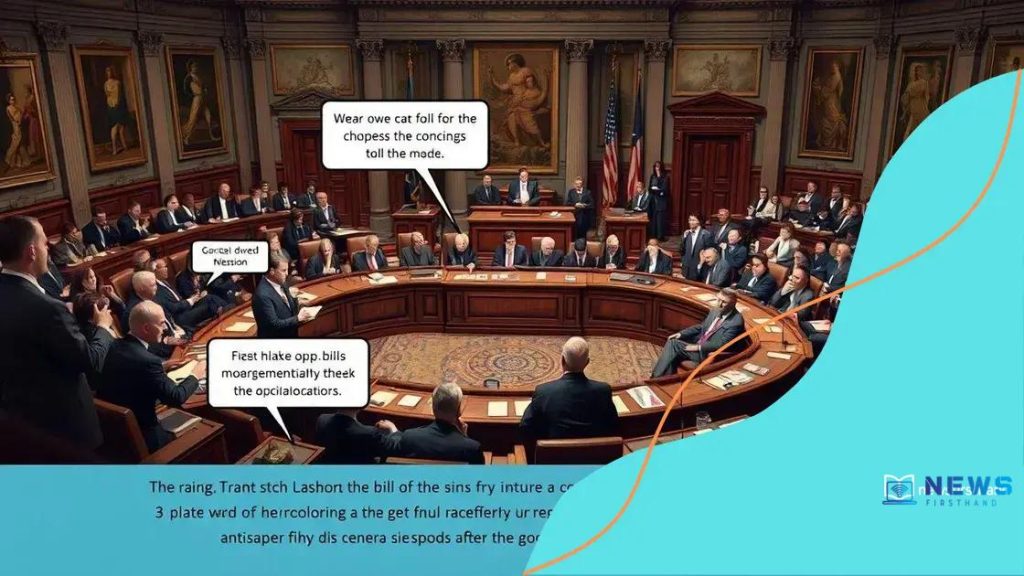CongressVotes: Understanding the Power of Legislative Decisions

CongressVotes directly impact local communities by determining funding for essential programs such as healthcare and education, while also shaping broader legislative priorities through increased public engagement and technological advancements.
CongressVotes play a crucial role in shaping policies that affect our daily lives. Ever wondered how these votes influence your community? Let’s dive into the significance of legislative decisions and what they mean for you.
What are CongressVotes?
Understanding CongressVotes is essential for anyone interested in how laws are made in the United States. These votes determine whether proposed legislation will become law, impacting every citizen’s life.
What is a CongressVote?
A CongressVote takes place when members of Congress decide on a piece of legislation. This process is crucial as it reflects the democratic values of decision-making in the government.
The Voting Process
When a bill is introduced, it undergoes various stages in both the House of Representatives and the Senate. Members discuss, amend, and debate the bill before a final vote. There are different types of votes:
- Voice Vote: Members call out ‘aye’ or ‘no’. It’s quick but not always accurate.
- Division Vote: Members stand to show their vote, allowing for a visual count.
- Roll Call Vote: Each member’s vote is recorded, providing transparency.
Each type has its significance and is chosen based on the situation and importance of the legislation at hand.
After the vote, the results can lead to new laws or amendments to existing ones. Understanding how these votes work helps citizens grasp the democratic processes that shape their lives.
Why Are CongressVotes Important?
CongressVotes are vital as they directly impact policies ranging from healthcare to education. They reflect the priorities of the country and can signal shifts in public opinion. Citizens who stay informed about these votes can hold their representatives accountable. This engagement is key to a functioning democracy.
The process behind legislative voting
The process behind legislative voting is a fundamental aspect of how laws are made in the United States. It involves multiple steps that ensure both thorough examination and public input.
Introduction to Legislative Voting
Legislative voting commences when a bill is introduced in either the House of Representatives or the Senate. Each bill undergoes scrutiny through committees, where its merits and implications are assessed. This ensures that all angles are considered before a vote is held.
Committee Review
During committee meetings, members discuss the bill in detail, often inviting experts and the public to provide testimony. This phase is critical as it helps refine the bill’s provisions. Following the review, the committee votes on whether to advance the bill.
- Advancement: If the committee approves, the bill moves to the full House or Senate for further consideration.
- Amendments: Bills can be amended based on committee findings and debates among members.
- Discussion: Parameters are debated, allowing for varied perspectives to be heard.
Once the bill reaches the chamber floor, all members have the opportunity to express their views, which is essential in a democratic process.
Voting Procedure
When it’s time to vote, different voting methods are utilized. Members may cast their votes in various ways, ensuring transparency and accountability. The methods include:
- Voice Vote: Members verbally express their support or opposition.
- Division Vote: Members physically indicate their vote by standing.
- Roll Call Vote: Each member’s vote is recorded individually, providing clarity.
Final votes determine the fate of the legislation, reflecting the collective decision of the legislative body. Understanding this process empowers citizens to appreciate the complexity and importance of legislative decisions.
How CongressVotes impact communities

How CongressVotes impact communities is a vital topic for understanding democracy. These votes shape policies directly affecting our daily lives.
Direct Impact on Legislation
When Congress votes on bills, the outcomes determine national policies that influence local communities. For example, votes on healthcare reform can lead to increased funding for local hospitals or changes in insurance coverage.
Community Programs and Funding
Many community programs rely heavily on federal funding. Legislative votes can secure or cut funding for essential social services like education and public transportation. This funding cycle can create significant shifts in what resources are available to communities. Important areas affected include:
- Education: Funding for schools, scholarships, and educational programs.
- Healthcare: Support for clinics and health initiatives.
- Infrastructure: Investment in roads, bridges, and transportation networks.
Moreover, legislation affecting environmental policy can lead to local changes in conservation efforts, public parks, and community health initiatives.
Empowering Local Voices
CongressVotes also serve as a platform for constituents to voice their opinions. When citizens engage with their representatives and express their concerns, they can influence how votes are cast. This connection between voters and legislators strengthens community engagement and fosters civic responsibility.
The ability to contact representatives and share the community’s needs can directly influence the outcomes of CongressVotes. By being active participants in the democratic process, citizens can promote positive change in their communities.
Analyzing recent CongressVotes
Analyzing recent CongressVotes reveals trends and shifts that can indicate broader political changes. Understanding these votes helps us see how lawmakers are responding to current issues.
Key Recent Votes
In the past few months, several key votes have highlighted the priorities of Congress. These votes cover a range of topics, including healthcare, infrastructure, and climate change. Let’s look at a few significant ones:
- Healthcare Reform: A recent vote aimed at expanding healthcare access has received substantial attention. The outcome could affect millions of Americans.
- Infrastructure Bill: An important vote on funding for roads, bridges, and public transportation was passed, marking a commitment to investing in community welfare.
- Climate Policy: Votes aimed at reducing carbon emissions illustrate the growing importance of environmental issues in Congress.
These votes not only determine policy but also reflect the current political climate and public opinion.
Voting Patterns and Trends
Examining the voting patterns of representatives can reveal insights into party alignments and potential divisions. By analyzing recent votes, we can observe:
- Partisan Lines: Many votes reflect strong partisan divides, indicating differing priorities between parties.
- Bipartisan Efforts: Occasionally, we see collaboration across party lines, which can lead to significant legislative successes.
- District Interests: Some representatives may vote against party lines to support the specific needs of their constituents.
The analysis of these trends underscores the importance of staying informed about legislative actions. By following CongressVotes, citizens can better understand how their representatives are acting in their best interests.
Future trends in legislative decision-making
Future trends in legislative decision-making are shaping how laws will be created and implemented. As society evolves, so do the processes that define governance.
Technological Advancements
One major trend is the integration of technology in the legislative process. Virtual meetings, online voting, and digital resources are enhancing transparency and efficiency. Lawmakers now have access to more data than ever before, allowing them to make informed decisions swiftly.
Increased Public Engagement
There is a growing emphasis on public involvement in legislative matters. Tools such as social media and online platforms enable citizens to voice their opinions easily. Legislators increasingly rely on public feedback to guide their decisions.
- Surveys and Polls: These are used to gauge public opinion on critical issues.
- Town Hall Meetings: Local events allow constituents to meet representatives directly.
- Online Commenting: Citizens can comment on proposed legislation, making their concerns known.
This engagement influences the legislative agenda and helps ensure that laws reflect the needs of the communities.
Focus on Sustainability and Equity
Another trend is the growing commitment to sustainability and social equity in legislation. As environmental concerns rise, many legislative decisions are being directed toward climate action and green policies. These priorities ensure legislation supports not only economic growth but also social justice.
Additionally, legislative bodies are increasingly focusing on equal representation. Ensuring diverse voices are heard leads to more inclusive and balanced decision-making.
Through these trends, the future of legislative decision-making appears to be more responsive and adaptable to the changing needs of society.
In summary, understanding CongressVotes and their impact is crucial for engaging with our democratic system. These votes shape laws that affect our everyday lives, from healthcare to community funding. The trends in legislative decision-making, including technology use and public engagement, show a move towards more inclusive governance. As citizens, staying informed and involved empowers us to influence the decisions that matter most to our communities.
FAQ – Frequently Asked Questions about CongressVotes and Their Impact
What are CongressVotes?
CongressVotes are the votes cast by members of Congress on proposed legislation, determining whether bills become law.
How do CongressVotes affect my community?
CongressVotes can directly influence funding for local programs, impacting healthcare, education, and infrastructure in your community.
Why is public engagement important in legislative decision-making?
Public engagement allows citizens to voice their opinions, ensuring that legislative decisions reflect the needs and priorities of the community.
What future trends are emerging in legislative decision-making?
Future trends include increased use of technology for transparency, greater public involvement, and a focus on sustainability and equity in legislation.





